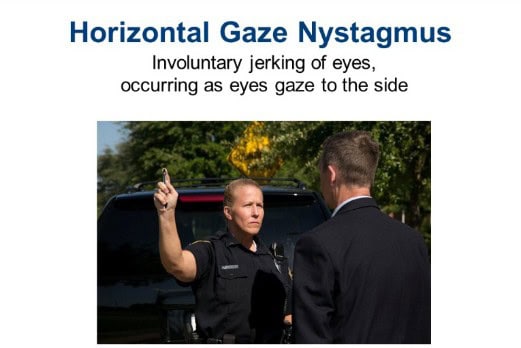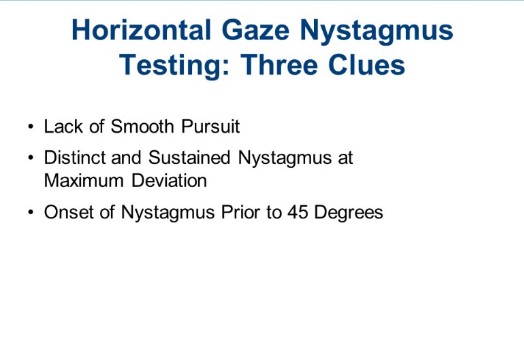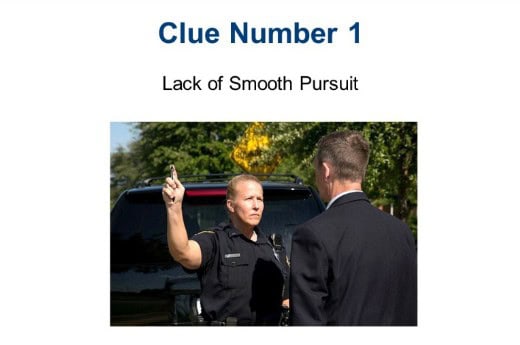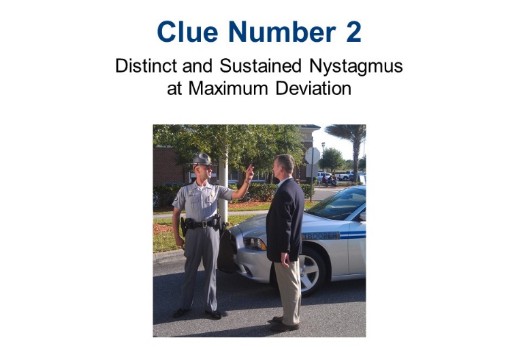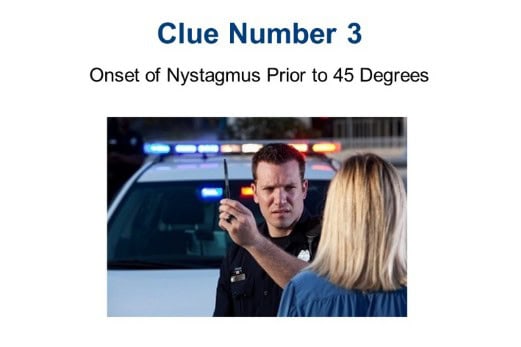Testing Your Eyes – The HGN Test in DWI and DUI Cases
As an initial matter, there is an ongoing and legitimate debate on whether to call field sobriety tests “tests” at all, since they are not pass/fail in the traditional meaning of the word test. They are perhaps better described as divided attention tasks, which we have written about in detail before. Officers have drivers suspected of DWI perform these tasks in order to look for certain clues that are meant to indicate or suggest whether a person is under the influence of alcohol or other mood-altering substance. Nevertheless, this post will refer to field sobriety tests as such, since this is their most common label, and for the sake of uniformity.
One of the key tools used in field sobriety tests is the Horizontal Gaze Nystagmus (HGN) test. The HGN test is one of the three standardized field sobriety tests used by law enforcement officers to identify impairment. During the test, the officer observes the eyes of a suspect as they follow a slowly moving object, such as a pen or flashlight, to detect signs of impairment indicated by the presence of nystagmus. While we have written previously on the topic of HGN-testing in the article linked above, this article explores the HGN test in detail, with a particular focus on its application in the field, and the ways in which an experienced Minnesota DWI lawyer can challenge the weight and use of HGN-testing at trial on a variety of bases. Much of the information in this article is derived directly from the training manual used throughout the state of Minnesota to train law enforcement in the administration of field sobriety tests. This manual, titled DWI Detection and Standardized Field Sobriety Test (SFST) Instructor Guide, is a 541-page “living document” established by the National Highway Traffic Safety Administration (NHTSA) that is continually updated in an effort to reflect present-day scientific consensus around field sobriety testing, and as necessary to reflect and instruct on law enforcement best practices. It can also be a DUI lawyer’s best friend, because it contains extremely detailed instructions in how field sobriety tests are to be conducted. It may come as a surprise, but it is rare for an officer to administer the HGN test in strict conformity with his or her training. For those interested, the NHTSA manual is linked at the bottom of this article.
What is Horizontal Gaze Nystagmus?
Nystagmus refers to an involuntary jerking of the eyes as they gaze to the side. Nystagmus can occur naturally as the result of a medical condition, but it is typically present or exaggerated by the consumption of alcohol or other central nervous system depressants. In addition to nystagmus being involuntary, a person exhibiting nystagmus is usually unaware that it is happening, and moreover, unable to control it. Because HGN is not the only kind of nystagmus, it is important to know the other types of nystagmus because an officer may have mistaken one for the other. Other types of nystagmus include:
Vestibular Nystagmus. The vestibular system is a sensory system located in the inner ear that creates our sense of balance and spacial orientation. More specifically, it provides information to the brain, and consequently to the eyes, about the position and movement of the head in order to maintain orientation and balance. Vestibular nystagmus is caused by movement or action within the vestibular system. For example, if a person spins rapidly around, the fluid in the inner ear will be disturbed during the period of spinning and for a short time afterward. Because of this, there is both rotational vistublar nystagmus (the nystagmus that would occur if we could observe the eyes of a person while they are in the physical act of spinning) and post-rotational vestibular nystagmus (the nystagmus that sticks around for a brief period of time after spinning). The NHTSA manual instructs that neither rotational nor post-rotational vistibular nystagmus will interfere with HGN-testing when administered properly. As we know from our experience, HGN-testing is routinely administered improperly. If a person is subject to HGN-testing in the immediate aftermath of rapid movement or other trauma, vestibular nystagmus should not be ruled out as a possible explanation for the presence of nystagmus.
Neural Nystagmus. There are two types of neural nystagmus unrelated to alcohol or drug use: Optokinetic Nystagmus and Physiological Nystagmus.
- Optokinetic Nystagmus may occur when the eyes fixate on an object that suddenly moves out of sight, or when the eyes watch sharply contrasting moving images. Examples of Optokinetic Nystagmus include watching strobe lights, rotating lights, or rapidly moving traffic in close proximity. The NHTSA manual states that the HGN test will not be influenced by Optokinetic nystagmus when administered properly. Note those words again: when administered properly.
- Physiological Nystagmus is a form of natural nystagmus that keeps the sensory cells of the eye from tiring. It is the most common type of nystagmus, and occurs in nearly everyone. The NHTSA manual states that these tremors of the eyes are usually too small to be seen with the naked eye.
Pathological Disorder Nystagmus. Certain pathological disorders will also cause nystagmus in the eyes. These include brain tumors, other brain damage, and some diseases of the inner ear. The NHTSA manual states that these conditions are rare in the driving population, but their absence should not be presumed. Prior to administering the HGN test, an officer is instructed to check for equal pupil size, resting nystagmus, and equal tracking (ensuring that the eyes follow an object together). If the eyes do not track together, or if the pupils are noticeably unequal in size, the chance of a medical disorder or injury causing the nystagmus may be present. If an officer bypasses these protocols, it is possible to cast doubt on all of the subsequent HGN-testing.
Conducting the HGN Test
The HGN test is conducted through a systematic process designed to identify specific signs of impairment in the eyes. However, it is not an exact science, and officers routinely deviate from the strict mandates set forth in the NHTSA manual. In conducting the HGN test, an officer is observing a subject for certain “clues.” The maximum number of clues that an officer may observe from a properly-administered test is six. These clues derive from an officer’s observation of each eye over the course of three exercises: Lack of Smooth Pursuit, Distinct Nystagmus at Maximum Deviation, and Onset of Nystagmus Prior to 45 Degrees. These are all discussed in detail below.
The Stimulus. The NHTSA manual makes clear that an officer needs to use a contrasting stimulus, such as a penlight, pen, or the officers finger, for the subject to follow with their eyes. An officer in a black uniform should not use a black pen. If this happens, it can cast doubt on the validity of the HGN test. The stimulus should be held approximately 12-15 inches in front of the subject’s nose and slightly above eye level. In our experience, the most-commonly used stimulus by officers is their finger.
Lack of Smooth Pursuit.
For this exercise, the officer moves an object horizontally in front of the suspect’s eyes and checks if their eyes can smoothly follow the moving object. Impairment may cause the eyes to jerk noticeably. The officer must hold the stimulus vertically 12-15 inches in front of the subject’s nose and slightly above eye level. Next, the officer must move the stimulus smoothly to the right as far as the eye can move and then all the way across the subject’s fact to the left, then back to the center. In other words, the stimulus must be moved from the center position, all the way out to the right (checking the subject’s left eye) until the eye can go no further, and then all the way back across the subject’s face all the way out to the left until the eye can go no further (checking the subject’s right eye) and then back to the center. The stimulus must move steadily, and at a speed that takes approximately two seconds to bring the eye from the center to the side. This means that to conduct the test properly (and therefore, in a way that has any scientific validity), an officer must use two seconds to bring the eyes to the right, four seconds to bring the eyes all the way to the left, and two seconds to bring the eyes back to the center. In other words, this test should take approximately eight seconds. In our experience, we have seen dozens of squad videos and body worn camera videos of officers using 3-4 seconds to conduct this test, which casts doubt over the whole exercise.
Distinct Nystagmus at Maximum Deviation.
For this exercise, the officer moves the stimulus to the farthest point the eye can reach and holds it there. In an impaired individual, the jerking of the eye becomes more pronounced at this point of “maximum deviation.” As with the first test, the officer must hold the stimulus vertically 12-15 inches in front of the subject’s nose and slightly above eye level. Next, the officer moves the stimulus to the right (checking the subject’s left eye) until the eye has gone as far as possible. The officer must hold the stimulus at this point of maximum deviation for a minimum of four seconds and carefully watch the subject’s eyes. The NHTSA manual states that in order to “count” this clue as evidence of impairment, the nystagmus itself must be distinct and sustained for a minimum of four seconds, going on to advise officers that “[i]f you think you see only slight nystagmus at this stage of the test or if you have to convince yourself nystagmus is present, then it isn’t really there.” In another section of the NHTSA manual, it is noted that four seconds is a relatively long period of time, and “[y]ou cannot simply hold the eye to the side for an instant and expect to observe distinct jerking.” Despite these admonitions, it is commonplace for officers to not hold their stimulus at maximum deviation for a minimum of four seconds. This test is often rushed, and if that is the case, a competent DWI attorney will use it to their advantage in front of a judge or jury.
Onset of Nystagmus Prior to 45 Degrees.
The officer moves the object slowly from the center to the side. If nystagmus begins before the eye has moved 45 degrees from the center, it indicates a higher likelihood of impairment. As with the first and second test, the officer must hold the stimulus vertically 12-15 inches in front of the subject’s nose and slightly above eye level. Next, the officer must move the stimulus slowly in the direction of 45 degrees from the subject’s eye. If the officer sees the subject’s eye jerk, they are to stop moving the stimulus, hold it at that position, and verify that the jerking continues. If jerking is not evident when the stimulus is held steady, the officer has not located the onset of nystagmus prior to 45 degrees. The NHTSA manual instructs that an officer must move the stimulus at a speed that takes approximately four seconds or more to travel from center to approximately 45 degrees. If the officer moves the stimulus faster than this, the validity of the test is subject to suspicion.
Counting Clues
As stated above, there are a total of six clues that an officer may observe during the HGN test. This is the multiple of two eyes and the three exercises discussed above. That is, an officer can observe one clue for each eye for each test. As an example, if an officer observes a lack of smooth pursuit in each eye, but no distinct nystagmus at maximum deviation nor the onset of nystagmus prior to 45 degrees, the officer will have observed two clues total. According to the scientific research cited in the NHTSA manual (which is not debated in this article), if a person exhibits at least four out of six clues, “the implication is a BAC above .08.” Notice this unique phrasing. The manual does not go so far as to say that a person is impaired if they exhibit at least four clues, but only that there is an implication of a BAC above.08. This says very little about impairment. Moreover, even when the HGN test is administered in strict adherence to the protocols in the NHTSA manual, the test is only 88% accurate. This number drops significantly the moment an officer’s administration of the test departs from the NHTSA manual. None of this should be taken as Monday morning quarterbacking of the officers. Our lawyers have litigated these issues successfully in trial.
Defense Strategies Against HGN Test Results
Defendants in Minnesota have several avenues to challenge HGN test results. Usually it is not possible to keep the HGN test out of trial altogether, but instead, the question becomes what amount of weight a jury should give to the test. The three primary means of challenging the HGN test are as follows:
- Questioning Officer Training and Certification. Ensuring the officer had adequate training and followed proper procedures is critical. Any deviation from the standardized procedure can cast doubt on the test results.
- Medical and Health Conditions. Presenting evidence of medical conditions that could cause nystagmus can challenge the reliability of the test results. Conditions such as inner ear disorders, neurological disorders, or the use of certain medications can result in nystagmus unrelated to alcohol consumption.
- Environmental and External Factors. Arguing that external factors such as poor lighting, improper instructions, or distractions such as an officer’s flashing squad lights affected the test’s administration can be a viable defense strategy. And any factor that could have influenced the accuracy of the test results can be highlighted to create reasonable doubt in a jury.
Training and Certification of Administering Officers
The accuracy and reliability of the HGN test heavily rely on the training and experience of the administering officer. A new officer may not have sufficient experience in conducting the test in the field. Conversely, an experienced officer may be well-trained, but may be so accustomed to administering the test that he may simply go through the motions without taking the time to administer the test properly. In Minnesota, officers undergo specialized training to become certified in administering field sobriety tests, including the HGN test.
During training, officers learn, among other things, the following:
- Scientific Basis of the HGN Test. Understanding how alcohol affects eye movements and why nystagmus occurs.
- Proper Administration Techniques. Learning the precise procedures for conducting the test to ensure consistency and reliability.
- Recognition of Nystagmus. Developing the ability to accurately observe and interpret the signs of nystagmus.
- Documentation and Reporting. Properly recording the test results and observations to ensure they are documented for later use and testimony in court proceedings.
Continued education and re-certification are often required to maintain proficiency and stay updated with any changes in procedures or legal standards. This is why the NHTSA is referred to as a “living document.”
Conclusion
Understanding the intricacies of the HGN test and its application under Minnesota law is crucial for both law enforcement and legal professionals. For drivers, awareness of these procedures and their legal implications is important, especially in maintaining one’s rights during DUI investigations. As with all legal matters, staying informed and seeking expert advice when necessary is the best approach to navigating the complexities of DUI laws and field sobriety tests.
The role of the HGN test in field sobriety testing is primary. It is, according to the NHTSA manual, the first and most accurate test among the battery of field sobriety tests available to an officer. However, it is not without limitations. To begin, just as a matter of science, it is only able to classify about 88% of subject accurately. This means that it is deficient more than 1 in 10 times of its administration. Additionally, there is great potential for error when the test is not administered correctly. A competent Minnesota DUI attorney will know how to pick the HGN test apart, and if the errors stack up high enough, a judge or jury is free to disregard the test altogether.
A Quality DWI Lawyer is Important
DWI charges can have a significant impact on your livelihood, family, freedom, and reputation. Quality legal representation is important so that you protect what is most important to you. The experienced DWI lawyers at Lundgren & Johnson can help. They have successfully litigated at trial the issues discussed in this article. They know how to put in the hard work in each case. Our lawyers can be reached at (612) 767-9643 or by using the contact form below. And as promised, here is a link to the latest version of the NHTSA manual:
DWI Detection and Standardized Field Sobriety Test (SFST) Instructor Guide (2023)


